As we await the Georgia election results and tomorrow’s Congressional farce, how about some sports?
Kansas City #15: One of the top-selling jerseys in the country is #15 of the Chiefs. Patrick Mahomes. Who is also a part owner of the Royals. So why not a Royals #15 for Mahomes? Sporting goods retailer Scheels tweeted out a photo of their store display:

But wait a minute. Whit Merrifield wears #15 for the Royals. Leading to some good natured twitter banter by Whit and Patrick.

And then to a modified display at Scheels.

Here’s hoping for a great 2021 for both of them…
Another Super Bowl victory for Mahomes. Go Chiefs!
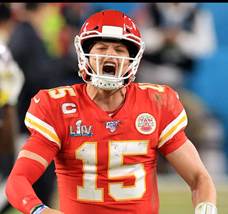
A full baseball season for Whit, Royals owner John Sherman and his fellow owners, including Patrick. Go Royals!
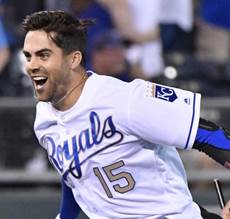
Dick Allen (RIP): Dick Allen wore #15 for the Phillies, Cardinals, Dodgers and White Sox during his 15-year MLB career. His early career was tainted with racism. Fans were not ready to cheer a Black player in Little Rock in 1963 and in Philadelphia in 1964 (the Phillies had been the last NL team to integrate, and even then reluctantly). This was the middle of the Civil Rights Movement, and even Allen’s Rookie of the Year performance was not enough to satisfy the fans.
Allen caused some of his own problems. He was not always a model player. There were reports of missed games, being drunk or high, and arguments with management and the league. In a 2019 article, Joe Posnanski recounted a comprehensive list of how different people viewed Allen: “He has been called brilliant, selfish, egotistical, misunderstood, a misanthrope, a charmer, a free-spirit, a jerk, a con-man, a team player, a maverick, a mystery, a Hall of Famer, a non-Hall of Famer and a genius.”
There was even controversy about his name, but that was not his fault. He wanted to be known as “Dick” (as he had been in the minors), but the Phillies started using “Richie” (possibly to make, in their minds, the Black player less threatening). Allen objected, saying he was a 22-year-old man and Richie was not a man’s name. But the sportswriters and baseball card companies did not listen for many years.
Coincidentally, the “Richie” card below includes another controversial name. When Roberto Clemente reached the majors in 1955, he was surprised to find that the media was referring to him as “Bob” and “Bobby.” It was part of the double discrimination he endured for being Black and from Puerto Rico. The press even mocked his broken English. He rejected the nicknames, but even after his MVP year in 1966, his 12th season, Topps was still calling him Bob.
When Henry Aaron came to the big leagues, the Braves’ public relations director began referring to him as “Hank” in an effort to make the quiet player appear more accessible. Both names are commonly used, and Aaron apparently has no objection – his autobiography is titled I Had a Hammer: The Hank Aaron Story.

After six seasons with the Phillies (1964-1969), Allen moved on from the booing in Philadelphia to the Cardinals, Dodgers and White Sox. He continued to be one of the best hitters in baseball, but controversy always followed him. His reputation was so bad that years later Bill James would write that Allen “did more to keep his teams from winning than anybody who ever played major league baseball. And if that’s a Hall of Famer, I’m a lug nut.” Ouch.
In 1975, at the urging of Mike Schmidt and other Phillies players, Allen returned to Philadelphia for two years. He became a free agent in 1977, and only Charlie Finley would sign him. His Oakland tenure was short – he abruptly retired in June of 1977 at age 35.
Although his bat was Hall-of-Fame caliber, his unpopularity with the press led to low vote totals on HOF ballots. He was also considered in 2015 by the Golden Era Committee, but missed entering the HOF by one vote. That committee was scheduled to meet again this year, and Allen was a presumptive candidate for election. The voting date was set for December 6, but it was postponed because of the pandemic. Allen died on December 7 at age 78.
As for Allen’s #15, the Phillies made some amends in September of 2020. By tradition, the Phillies had not retired a number unless the player was in the Hall of Fame. They made an exception for Allen. Mike Schmidt spoke at the ceremony, “Dick was a sensitive Black man who refused to be treated as a second-class citizen…He played in front of fans who were products of that racist era…[and alongside] racist teammates…different rules for whites and Blacks.”
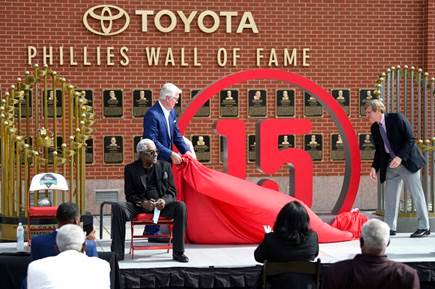
[Kansas City Trivia: In the photo above, Dick Allen is seated while his number is unveiled. At the left of the stage is a large replica of the 1980 World Series trophy that is part of the Phillies Hall of Fame plaza at their stadium. It was the first-ever Series win for them, and their opponent was the Kansas City Royals. Below, Rita next to the trophy when we attended a game in Philadelphia in 2019. It’s hard to see, but there is a blue Royals logo on the base.]

In addition to his bat, Allen will be remembered for an iconic Sports Illustrated cover from 1972. SI photographer John Iacono was in Chicago to take photos of Allen for a brief piece on several players who were the “surprises of the season.” Among the many photos of Allen was one in the dugout. Iacono: “All of a sudden, he started juggling. And I thought, Holy crap, this is perfect.”
When Iacono got back to New York, he was surprised to find that his juggling photo of Allen was on the cover. He was in for another surprise. Iacono had been so focused on the juggling that he had missed the dangling cigarette – no doubt one of the reasons it was chosen for the cover. The article inside the magazine had only one sentence on Allen, “Nomadic and nonchalant Dick Allen (see cover), who could be almost anywhere is now in Chicago, and surprise of surprises, he seems to like it there, hitting game-winning homers and receiving homage as the White Sox leader.”
Allen received a reprimand for allowing his dugout smoking to be captured on the cover. When Iacono ran into Allen weeks later, he apologized for getting him in trouble. Allen laughed and said he was enjoying the great publicity. The smoking/juggling Allen went on to be the AL MVP that year.

Dick Allen may not yet be in the Hall of Fame in Cooperstown, but he is in the “Hall of Game” at the Negro Leagues Baseball Museum. The award honors former MLB greats who competed with the same passion, determination, skill and flare exhibited by the heroes of the Negro Leagues. Below, Allen at the NLBM when he received his award in 2018.

Phil Niekro (RIP): On December 26, Phil “Knucksie” Niekro died at age 81, prompting Wall Street Journal columnist Jared Diamond to write…
“There’s no crying in baseball. Except in 2020. If there’s a Baseball Heaven, the team of players who died in 2020 is loaded. It features seven Hall of Famers, including four of the best pitchers of all-time and three superstars of the 1960s and ‘70s in the field. And that doesn’t include one of the most prodigious hitters of the era who hasn’t made it to Cooperstown.”
The prodigious hitter is Dick Allen. The seven Hall of Famers are Al Kaline, Joe Morgan, Lou Brock, Whitey Ford, Tom Seaver, Bob Gibson and Phil Niekro.
Among hurlers with 300 wins, Niekro took the most unlikely path. From 1964 to 1966, including time in the minors, he was used by the Atlanta Braves in relief. He picked up six major league wins in those three years. In 1967, at age 28, he became a starter and won another 312 games before retiring in 1987 at age 48. Of his 318 wins, 121 came after he was 40 years old.
The reason for Niekro’s longevity was that his signature pitch was the knuckleball. His durability is best measured by the number of innings he pitched – 5,404 – the most by any pitcher in the live-ball era (since 1920). He had 245 complete games. In 1979, he led the league in wins AND losses (21-20). His final win-loss was 318-274.
He and his brother Joe learned the knuckleball from their coal-miner father. The Niekro brothers combined for 539 major league victories, just ahead of brothers Gaylord and Jim Perry who had 529 wins.
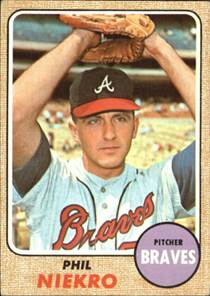
Some descriptions of his knuckler. Bobby Murcer: “Trying to hit Phil Niekro is like trying to eat Jell-O with chopsticks.” Rick Monday: “It actually giggles at you as it goes by.” Ernie Banks: “It comes flying in there dipping and hopping like crazy, and you just can’t hit it.” Pete Rose: “I work for three weeks to get my swing down pat and Phil messes it up in one night. Trying to hit that thing is a miserable way to make a living.”
If Pete Rose was miserable, how about Niekro’s catchers? When Niekro was first playing for Atlanta, the starting catcher was Joe Torre. But the chasing of passed balls and wild pitches, a common result of knuckleballs, was bad for Torre’s overall performance. Paul Richards, GM of the Braves, had managed knuckleballer Hoyt Wilhelm at Baltimore and designed the first oversized catcher’s mitt to corral the fluttering pitch. Richards needed a good defensive catcher who could spell Torre and be Niekro’s personal catcher. In June of 1967, he acquired Bob Uecker in a trade with the Phillies. Smart move.
Uecker was a light-hitting catcher who was more than happy to have a regular gig every four games. Not that it was easy. One of Uecker’s patented lines was that the best way to catch a knuckleball was “to wait until it stopped rolling and pick it up.” In 1967, the only year they were battery-mates, Niekro led the league in ERA (1.87) and wild pitches (19), while Uecker led in passed balls (27). But Uecker had done what Paul Richards had wanted. Proved that Phil Niekro was a major league starter. Niekro’s opinion: “Uecker turned my career around.”
Below, Niekro showing his knuckler grip and Uecker anticipating the pitch.
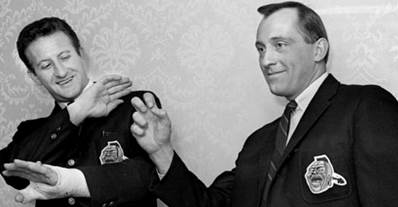
That 1967 season was Uecker’s last year as a player. He went on to become a witty celebrity and popular baseball broadcaster. I took a look at my copy of his 1982 book (Catcher In the Wry) to see what he had to say about his time with Niekro.
He wrote that he was lucky to have a job. “I was still a backup catcher…still in the twilight of a mediocre career. But something was different this time. I had become necessary. All because of a maddening pitch that had carried Phil Niekro to the majors and now threatened to carry him back.”
He also tells a Paul Richards story. A trainer said that Niekro’s pitching style would let him pitch without four days’ rest. GM Richards agreed with the trainer, but said four days was still necessary. For Uecker.
Uecker said he had the same ritual before each Niekro game. “I took four aspirins for the headache I knew I would have afterwards.”
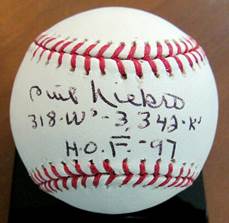
Niekro pitched 21 seasons for the Braves, the last two managed by his original catcher Joe Torre. After the 1983 season, the Braves released Niekro, Torre saying, “When I was a catcher, I couldn’t catch him; when I was an opposing hitter, I couldn’t hit him; and the last two years, I’ve found I can’t manage him.”
Niekro had won 268 games for Atlanta. But he was not done. The 45-year-old signed with the Yankees and won another 50 games over the next four seasons with the Yankees and Indians. That’s how he got to 318.
Niekro and Uecker became lifelong friends. Niekro continued to credit Uecker for saving his career, and he in turn took credit for inspiring knuckleball jokes that enhanced Uecker’s comedy routine. Three days before Niekro died, he called Uecker from his hospice bed. They had a good conversation that Uecker says ended like this: “He called me The Chaser and I called him The Thrower. That was our nicknames for each other. He told me, ‘Chaser, I’m getting tired, and I think I’ll go to sleep for a while.’”
Lonnie’s Jukebox – Two New Year’s Eve Traditions: Since 2005, John Lennon’s song “Imagine” has been played just before the ball drops at Times Square on New Year’s Eve. It is that moment when much of the world unites to count down the old year, either by being in Times Square or watching on television. The song’s message of unity, peace and the brotherhood of man is a hopeful signal for better things in the new year. That message is especially relevant as we move to 2021.
You may say I’m a dreamer
But I’m not the only one
I hope someday you’ll join us
And the world will be one
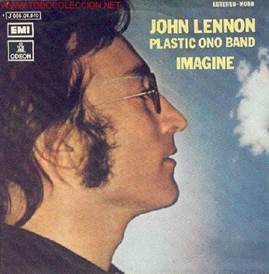
The combination of New Year’s Eve and a message of peace makes me think of Woody Overton. On New Year’s Eve in 1977, Rita and I plus several other couples ended up at the Brewery in Brookside during an ice storm. That was our first New Year’s Eve with Woody and Jane Overton. It became a tradition for the four of us, and the streak ran for 40 consecutive years before Woody died in February of 2017. Below, we toast to 2013.

The tradition continues with Jane, and last week was our 44th year in a row. Even though we live in the same condo building as Jane, this year’s participation was via a Zoom call joined by Barbara Reres and Joe and Cheryl Downs. And it was timed for the NY midnight, not KC’s.
As for Woody and peace, I went to my “Woody” file to find two items I remembered Woody had written. Woody’s active political life brought him close to many officeholders, one of whom was his good friend Senator Claire McCaskill. On March 9, 2009, Woody wrote a three-page letter to Claire, detailing why the new Obama administration should quickly act to end the war in Iraq. “As you know Senator, I am a proud parent and grandfather. If one of my family members were part of that 50,000 brave men and women left behind in Iraq for a war we cannot win, I would lose faith in my government as I did during the Vietnam War. Let us not repeat history…”
Two years later, on January 4, 2011, Woody sent a Washington Post column to many of his friends to show how the ongoing war was harmful to the country in so many ways. Woody prefaced the article with his own thoughts:
“A very good read. We are in a war we cannot afford or win and the loss of life of these brave, patriotic young men and women is outrageous. Nobody has made a strong case as to why we continue to be there. I thought after Bush, the Obama administration would no longer prolong these two wars. I spent two years in the Army at the height of the Vietnam War, 1969 to 1971. As a member of the 4th Division Honor Guard I spent 14 months going to funerals sometimes 5 a day (in the U.S.) of soldiers killed in another war we had no business being in. I saw the face…up close of families…mothers, fathers, wives, and husbands, children, friends devastated by the loss of their loved one. Obama these are your wars now! As in the article, I quote, “War is too important to be left to Generals.”
Woody’s experience during the Vietnam War had a big effect on him. After leaving the Army in 1971, he soon became active in politics, including supporting George McGovern in 1972. Woody was also influenced by the man dropped by McGovern from the 1972 ticket. In 1977, by then a seasoned politico, Woody joined the staff of Senator Tom Eagleton where he remained for a decade. A long-time key issue for Eagleton was the unchecked power of a president to wage war. He even wrote a book about it, War and Presidential Power: A Chronicle of Congressional Surrender.
Another McGovern supporter was John Lennon who had moved to New York in 1971. Lennon planned to appear in a series of concerts to help with voter registration and anti-war organization – this was the first election when 18-year-olds had the right to vote. As Lennon’s profile in the anti-war movement increased, he drew the attention of the Nixon White House and was placed under FBI surveillance. Also, the INS began deportation proceedings based on Lennon’s 1969 marijuana charge in London. On advice of counsel, Lennon laid low and was not able to follow through with the concert tour.
But the Nixon administration could do nothing about two popular Lennon anti-war songs. In 1969, Lennon had released his first solo single, recorded (photo below) at the “Bed-In” with Yoko Ono in a Montreal hotel (coincidentally the same hotel Woody, Jane, Rita and I stayed in when we vacationed in Montreal in 2013). The song was “Give Peace a Chance.” A detailed report on the bedroom recording (and the other people in the room) was in Hot Stove 111.

In 1971, Lennon recorded “Imagine,” which holds up after 50 years as an anthem for unity and peace. Lennon’s original recording of the song was initially used for the ball drop on Times Square, but starting in 2010, it has been performed live by various artists.
Leading us to the jukebox selections for today:
“Give Peace a Chance” (1969).
“Imagine” by X Ambassadors (2019/2020, Times Square with a crowd)
“Imagine” by Andra Day (2020/2021, Times Square without a crowd)
And the original, from 50 years ago…
“Imagine” by John Lennon (1971).
In closing, Rita’s iPad photo of our view as we awoke to snowfall on New Year’s Day of 2021.

TO ONE AND ALL, HAVE A HAPPY, HEALTHY AND SAFE NEW YEAR!
PEACE.